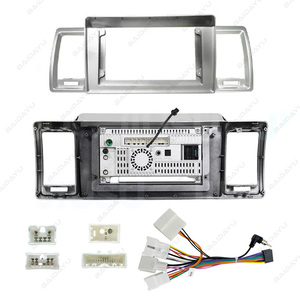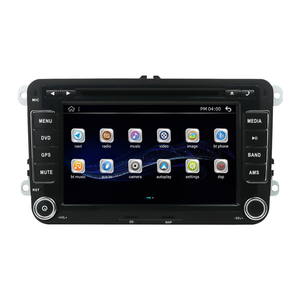(10413 products available)































































































































































































































The RDS radio system has become a standard feature in modern car audio systems, offering enhanced broadcasting services and improved listening experiences. RDS, which stands for Radio Data System, is a digital standard for embedding information in the FM radio signal. It allows for the transmission of additional data alongside the audio signal, enabling features like station identification, traffic announcements, and program information. RDS-equipped car stereos provide drivers and passengers with valuable information and increased safety by allowing them to access real-time traffic information and easily identify their favorite radio stations.
The RDS radio system comes in different types, each designed to meet specific needs. These include:
RDS Encoder
The RDS encoder is a standalone unit or an integral part of the radio transmission system that encodes RDS information into the audio signal. It has a maximum power consumption of about 10 watts. The RDS encoder has an interface for communication and control, such as Ethernet, serial port, or USB, and may include a built-in web server for remote control and monitoring.
RDS Decoder
The RDS decoder is used in RDS-enabled receivers, such as car radios, portable radios, and home audio systems. The RDS decoder extracts the encoded information and displays it on the screen or used for automatic tuning and other functions. The RDS decoder has a maximum power consumption of about 1-5 watts. It also has a user interface for displaying RDS information, such as a screen, remote control, or an integrated web server for remote control and monitoring.
RDS Data Services
The RDS radio system supports various data services that enhance the listener's experience. These services include:
RDS Signal Quality
RDS radios continuously monitor the quality of the received signal and display information about the level of interference, signal strength, and quality of service. This allows listeners to choose the best available station and be aware of potential problems with the reception.
RDS Compatibility
The RDS radio system uses standardized protocols and data formats for the interaction of various components and services. This ensures compatibility and interoperability between different manufacturers' equipment and systems. RDS-enabled devices must comply with RDS standards and specifications to ensure proper operation and data exchange.
RDS technology has become an integral part of modern radio broadcasting and enhances the listeners' experience. It provides additional information, automatic tuning, and improved reception quality, making RDS-enabled radios a valuable choice for radio listeners.
Wholesale buyers should consider the following factors when sourcing RDS radio systems:
Compatibility
RDS is a technology added to FM radio broadcasts, so the RDS radio system must be compatible with the existing radio infrastructure. Check that the RDS encoder, decoder, and associated components work seamlessly with the current radio system.
Functionality
The desired functionality of the RDS radio system must be established. The RDS radio system provides various features, such as text information, emergency announcements, and traffic information. Determine which functions are necessary to meet the audience's needs.
Scalability
Consider the scalability of the RDS radio system. Will the system be able to accommodate future growth if the coverage area or the number of channels increases? It is essential to choose a system that can be upgraded easily to avoid future limitations.
Reliability
The reliability of the RDS radio system is crucial to ensure continuous broadcasting and service. The reputation of the suppliers and the reliability of the systems they provide should be researched. Look for reviews and testimonials to gauge the performance and stability of the systems in real-world environments.
Budget
The budget for the RDS radio system must be determined. Consider not only the initial purchase and installation costs but also the long-term operating costs, such as maintenance, upgrades, and training. Find a balance between features, performance, and overall cost-effectiveness.
Technical Support and Training
Consider the availability of technical support and training services from the RDS radio system provider. Reliable technical support can solve problems quickly and minimize downtime. Training ensures that staff can use the system effectively and take full advantage of its features.
Legal Compliance
Ensure that the RDS radio system complies with local regulations and standards. Different countries and regions may have specific requirements for RDS implementation, including technical specifications and licensing. Verify that the system meets all legal requirements to avoid potential penalties or operational interruptions.
Replacing an RDS radio system can be a DIY-friendly task, but it requires following instructions carefully. Here are the steps to take:
Q1. What is the difference between DAB and DAB+?
A1. DAB+ offers improved audio quality, more efficient coding, and the ability to carry more stations than DAB. While DAB is still functional, DAB+ is its upgraded version.
Q2. Can RDS be added to existing FM radios?
A2. Yes, RDS can be integrated into many existing FM radios with the appropriate hardware and software upgrades. It is not limited to new radios.
Q3. What is the role of RDS in radio communication?
A3. RDS enhances the radio listening experience by providing additional information and services, making it an essential tool for broadcasters and listeners.
Q4. Are RDS radios more expensive than non-RDS radios?
A4. Generally, RDS radios can be slightly more expensive than non-RDS radios due to the added functionality. The cost difference may vary based on other features and the brand.
Q5. Can RDS be used for traffic information?
A5. Yes, RDS can broadcast traffic information, including TMC services, in real time. It allows listeners to receive updates on traffic conditions and avoid congested routes.